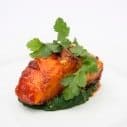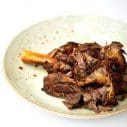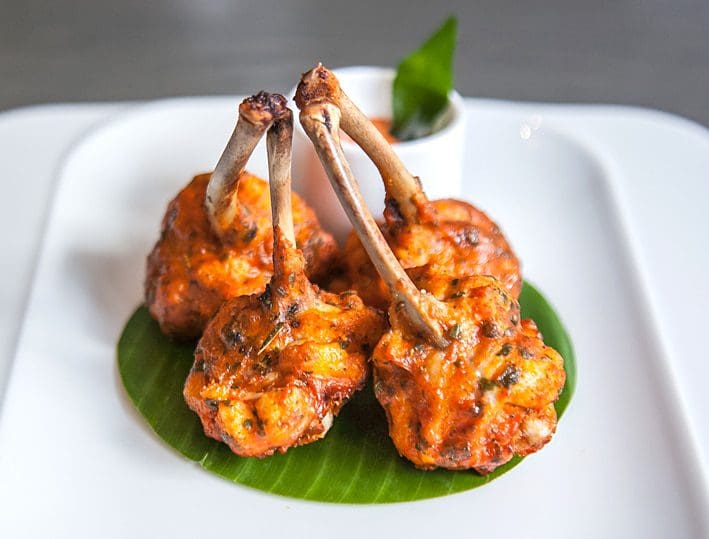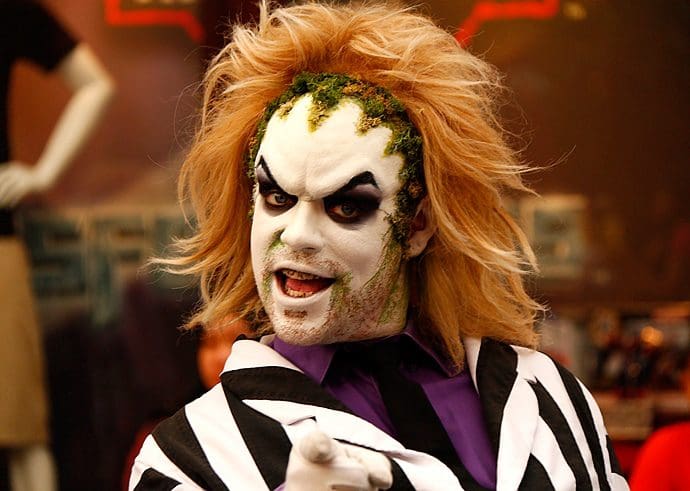Bombay Brasserie London review by Chris Zacharia
Nostalgia can be a powerful thing. Stepping into Bombay Brasserie London – named after a city which is now called Mumbai – I’m nostalgic for a place I haven’t even been to, a time in which I’ve never lived.
Sitting just across from the Gloucester Road underground stop, within the bosom of Bailey’s Hotel, it’s powerfully reminiscent of the old Raj. Which I’ve never experienced.
Bombay Brasserie certainly looks the part. There’s a glowing bar, spirits of amber and ochre gently shining in their vials and flasks. There’s a properly grand dining room, with a chandelier big enough to hold a treehouse. There are starched white tablecloths and well-groomed waiters and a concert pianist who looks like he’ll play you your favourite song, one more time, if you call him Sam. We’re seated in a comfortable conservatory with a great yawning skylight, all airy informality, the sense of freshness heightened with some well-chosen hanging plants and flowers. It is, in short, a very nice place to eat.
Putting aside the musket and mustache, there are some truly excellent starters to begin with here. Not least the Palak Patta Chat, which is like some kind of Indian upgrade of nachos – curls of fried spinach, which smash satisfyingly like thin ice upon being crunched, covered in a tamarind salsa, sour cream and a smattering of juicy pomegranate. It’s impossible to stop eating, a gooey, savoury mess of a dish, where dignity quickly fades in the quest to eat more. When he appears to collect the empty bowl, I tell the waiter how much we enjoyed the Palak Patta Chat. He smiles knowingly, as though he were expecting this all along.
“It is our signature recipe” he explains. “Many diners come especially for this”
I’m not surprised. The rest of the starters – a dense duck cake with cardamom and clove, a couple of impeccably-cooked scallops smothered in chili, a tidy little vegetable cake – are all worthy of sustained attention, but the Pulak Patta Chat has us swooning until way past dessert. I can feel a habit forming, mark my ruin.
This creativity extends beyond the starters. Again and again, Bombay Brasserie London show an admirable willingness to experiment and adapt the traditional fare of the British-Indian tabletop. Pappadums are miraculously free of grease, served with a subtle tomato dip which benefits from a fresh zinginess. Cocktails range from the traditionals to the twists, with a Bombay Breeze delivering an unexpectedly complex burst of cumin. And the wine-list, usually so conservative in Indian restaurants, benefits from the presence of some lesser known varieties, including some from India.
It quickly becomes very clear that there is an excellent tandoor oven here; each and every morsel which emerges with that smoked, almost charred appearance, is declared delicious. Lamb chops are everything you’d wish them to be: rich, molten until perfectly tender, the fat oozing through the crevices. A lump of monkfish, covered in a corn-coloured rub which we fail to identify, is another hit, the texture of the fish lilting dreamily through all sorts of softness. The basic goodness of the ingredients is allowed to shine through, enhanced rather than obscured by the spices.
Yet Bombay Brasserie’s meticulous upgrade of the tired curry-house formula hits major problems when it comes to the actual curries. Chicken tikka makhani presents chargrilled chunks of tikka’d chicken thigh in a thin, suspiciously silky tomato sauce which tastes eerily like Heinz Tomato Soup. It’s a butter-based dish, so the lack of spiciness is forgivable, but the sauce is just too one-note and pedestrian. We fish out the chicken instead.
Salli botti suffers from a similar problem: irresistible cuts of lamb, coated in a tomato sauce too strongly laced with vinegar. It lacks complexity, each mouthful too similar to the last. Prawn hara pyaz ka is another tomato-heavy dish which doesn’t get it right – the prawns, delicious in themselves, float in the sauce amongst the spring onions, refusing to mesh with its flavour. Dal makhani, loaded with black lentils, shares the same problems as its chicken cousin. There needs to be more fragrance, more fresh herbs, more oomph. Given the surfeit of spot-on flatbreads and fluffy rice on our table, we’re aching for a sauce that begs to be mopped up. Unfortunately all three leave the table unfinished, their meat and seafood long since extracted.
It’s a shame the sauces are off, because everything else is a big hit. Bhindi amchuri, okra partnered with mango powder, is crunchy and moreish. Desserts pick up where the starters and tandoor dishes left off. A chocolate samosa improves morale considerably – exquisitely flaky, the pastry contrasting nicely with the gooey chocolate centre. A raspberry and chocolate mousse is bouncy and light, while a passable chocolate brownie makes up the rear. Malai kulfi, a traditional Indian ice cream, improves each of them, its texture veering towards sorbet. It’s a reminder that the ingredients here are all top-notch, with a faultless freshness identifiable from the appetisers through to the puddings.
Those curries notwithstanding, Bombay Brasserie London is a very fine example of modern Indian cuisine with a dining room that you will wish was your own. A week later, and I’m still having flashbacks about that Palak Patta Chat starter, the tandoori monkfish, those molten lamb chops. Already I long to go back. Like I said, nostalgia is a powerful thing.














